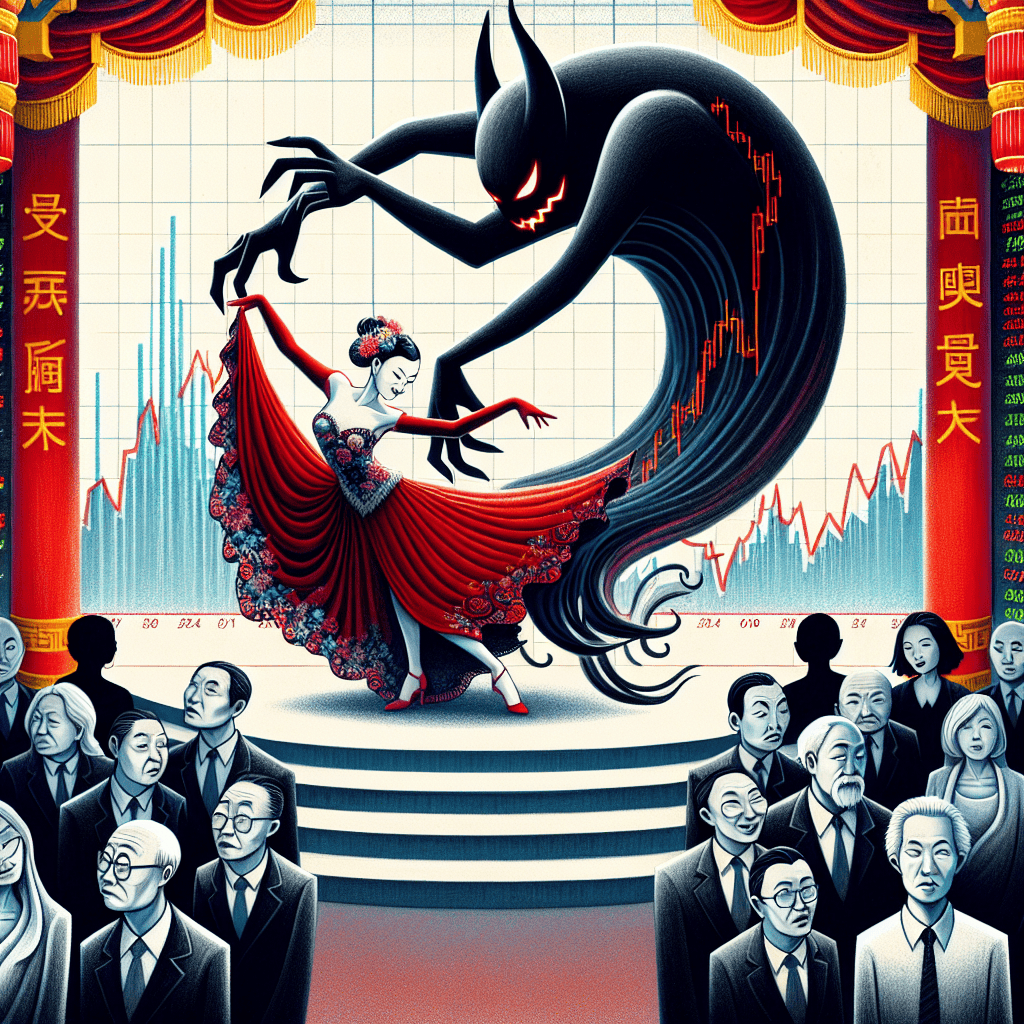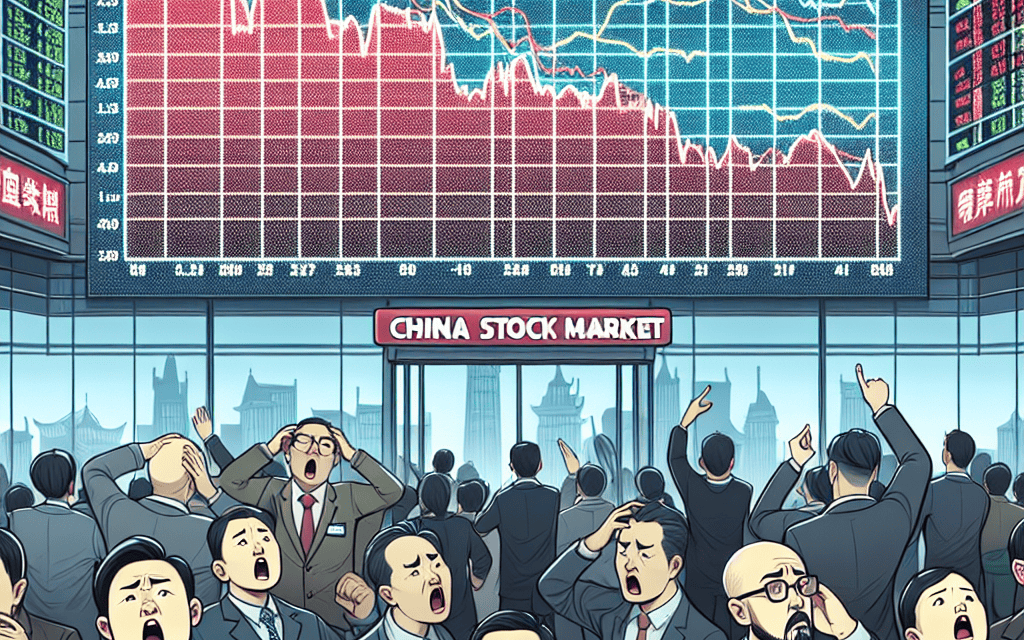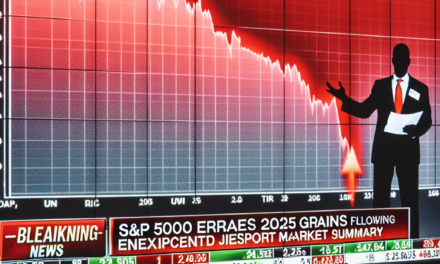“Chinese Stocks Teeter: Investor Patience on the Edge”
Introduction
Chinese stocks have recently entered a precarious phase, teetering on the brink of a market correction as investor patience begins to wane. This shift comes amid a confluence of factors, including regulatory crackdowns, economic uncertainties, and geopolitical tensions, which have collectively dampened investor sentiment. The once-booming Chinese equity market, which had attracted global attention with its rapid growth and lucrative opportunities, now faces mounting challenges that threaten to undermine its stability. As investors reassess their positions, the volatility in Chinese stocks underscores the fragile balance between market optimism and the realities of an evolving economic landscape.
Understanding the Recent Volatility in Chinese Stocks
In recent months, Chinese stocks have experienced significant volatility, leading to growing concerns among investors about the potential for a market correction. This turbulence can be attributed to a confluence of factors, both domestic and international, that have collectively eroded investor confidence. As market participants grapple with these uncertainties, it is crucial to understand the underlying causes of this volatility and the implications for the future of Chinese equities.
To begin with, regulatory pressures have played a pivotal role in unsettling the Chinese stock market. Over the past year, the Chinese government has intensified its scrutiny of various sectors, particularly technology and education, in an effort to address issues such as data privacy, anti-competitive practices, and social inequality. These regulatory crackdowns have led to significant sell-offs in affected industries, as investors reassess the growth prospects and profitability of companies operating within these sectors. Consequently, the broader market has been impacted, as the uncertainty surrounding future regulatory actions continues to weigh heavily on investor sentiment.
In addition to domestic regulatory challenges, geopolitical tensions have further exacerbated the volatility in Chinese stocks. The ongoing trade disputes between China and the United States, coupled with concerns over potential sanctions and export restrictions, have created an atmosphere of uncertainty that has made investors increasingly cautious. These geopolitical dynamics have not only affected investor confidence but have also led to disruptions in global supply chains, which in turn have impacted the performance of Chinese companies with significant international exposure.
Moreover, the Chinese economy itself has shown signs of slowing growth, adding another layer of complexity to the current market environment. Recent economic data has indicated a deceleration in key sectors such as manufacturing and real estate, raising concerns about the sustainability of China’s economic recovery post-pandemic. This slowdown has been attributed to a combination of factors, including energy shortages, rising commodity prices, and the lingering effects of the COVID-19 pandemic. As a result, investors are increasingly wary of the potential for a broader economic downturn, which could further pressure corporate earnings and stock valuations.
Despite these challenges, it is important to recognize that the Chinese government has taken steps to stabilize the market and restore investor confidence. Policymakers have implemented measures to support economic growth, such as easing monetary policy and increasing fiscal spending. Additionally, there have been efforts to improve transparency and communication with investors, particularly regarding regulatory intentions and economic policy objectives. These actions, while providing some reassurance, have yet to fully alleviate the concerns of market participants who remain cautious about the potential for further volatility.
In conclusion, the recent volatility in Chinese stocks can be attributed to a complex interplay of regulatory, geopolitical, and economic factors. As investors navigate this uncertain landscape, it is essential to remain vigilant and informed about the evolving market dynamics. While the potential for a market correction looms, the long-term prospects for Chinese equities remain tied to the country’s ability to address these challenges and sustain its economic growth trajectory. As such, investors must carefully weigh the risks and opportunities presented by the current environment, while maintaining a keen eye on developments that could influence the future direction of Chinese stocks.
Factors Contributing to the Correction in Chinese Markets
Chinese stocks have recently been flirting with a correction, a situation that has captured the attention of global investors and analysts alike. This development is not entirely unexpected, given the myriad of factors that have been influencing the Chinese markets. To understand the current scenario, it is essential to delve into the various elements contributing to this potential correction.
Firstly, regulatory pressures have been a significant factor affecting investor sentiment. Over the past few years, the Chinese government has implemented a series of stringent regulations across various sectors, including technology, education, and real estate. These measures, aimed at curbing monopolistic practices and ensuring fair competition, have led to increased uncertainty among investors. As a result, many have become cautious, opting to reassess their portfolios and reduce exposure to Chinese equities. This cautious approach has, in turn, contributed to the downward pressure on stock prices.
In addition to regulatory challenges, the Chinese economy has been grappling with slower growth rates. The COVID-19 pandemic, while initially well-managed in China, has had lingering effects on the country’s economic performance. Supply chain disruptions, coupled with sporadic lockdowns, have hindered manufacturing and export activities. Consequently, the anticipated robust recovery has not materialized as expected, leading to a more subdued economic outlook. This slowdown has inevitably impacted corporate earnings, further dampening investor enthusiasm for Chinese stocks.
Moreover, geopolitical tensions have also played a role in shaping market dynamics. The ongoing trade disputes between China and the United States, along with other geopolitical frictions, have created an environment of uncertainty. Investors are wary of potential escalations that could lead to further economic repercussions. This geopolitical backdrop has made it challenging for investors to predict market movements, prompting many to adopt a more conservative stance.
Another contributing factor is the evolving monetary policy landscape. The People’s Bank of China has been navigating a delicate balance between supporting economic growth and maintaining financial stability. While there have been efforts to inject liquidity into the system, concerns about rising debt levels and potential asset bubbles have necessitated a cautious approach. This has led to a tightening of credit conditions, which has, in turn, affected corporate financing and investment activities. The resultant impact on business operations has been reflected in stock valuations, adding to the correction pressures.
Furthermore, the global investment climate has also influenced Chinese markets. With interest rates rising in major economies like the United States, there has been a shift in capital flows. Investors seeking higher yields have redirected funds away from emerging markets, including China, towards more stable and lucrative opportunities. This reallocation of capital has exerted additional downward pressure on Chinese stocks, contributing to the correction narrative.
In conclusion, the potential correction in Chinese stocks is a multifaceted issue, driven by a combination of regulatory, economic, geopolitical, and monetary factors. As investor patience wanes, it is crucial for market participants to remain vigilant and adaptable. While the current environment presents challenges, it also offers opportunities for those willing to navigate the complexities of the Chinese market. Understanding these contributing factors is essential for making informed investment decisions in this evolving landscape.
Investor Sentiment and Its Impact on Chinese Stock Performance
Investor sentiment plays a crucial role in the performance of stock markets worldwide, and the Chinese stock market is no exception. Recently, Chinese stocks have been flirting with correction territory, a situation that has raised concerns among investors and market analysts alike. This development can be attributed to a confluence of factors that have tested the patience of investors, leading to a shift in sentiment that has had a tangible impact on stock performance.
To begin with, the Chinese economy has been grappling with a series of challenges that have contributed to the wavering confidence among investors. The lingering effects of the COVID-19 pandemic, coupled with regulatory crackdowns in key sectors such as technology and real estate, have created an environment of uncertainty. These regulatory measures, while aimed at ensuring long-term stability and sustainability, have nonetheless introduced short-term volatility, causing investors to reassess their positions. As a result, many have adopted a more cautious approach, leading to reduced trading volumes and increased market fluctuations.
Moreover, geopolitical tensions have further exacerbated the situation, adding another layer of complexity to the investment landscape. The ongoing trade disputes between China and other major economies, particularly the United States, have heightened concerns about the potential for economic decoupling and its implications for global supply chains. This geopolitical backdrop has made investors wary of potential disruptions, prompting them to reevaluate their exposure to Chinese equities.
In addition to these external factors, internal dynamics within the Chinese market have also played a role in shaping investor sentiment. The Chinese government’s commitment to transitioning towards a more consumption-driven economy has necessitated structural reforms that, while necessary, have introduced a degree of unpredictability. These reforms have included efforts to deleverage the economy, reduce reliance on debt-fueled growth, and address systemic risks within the financial sector. While these measures are intended to foster long-term economic resilience, they have also contributed to short-term market volatility, testing the resolve of investors.
Furthermore, the performance of Chinese stocks has been influenced by global economic conditions, which have been marked by rising inflationary pressures and tightening monetary policies in several major economies. These global trends have led to shifts in capital flows, with investors seeking safer havens amid the uncertainty. Consequently, emerging markets, including China, have experienced capital outflows, further impacting stock performance.
Despite these challenges, it is important to recognize that the Chinese market still holds significant potential for growth. The country’s large and increasingly affluent consumer base, coupled with its ongoing technological advancements, presents opportunities for investors willing to navigate the current volatility. However, the key to capitalizing on these opportunities lies in understanding the evolving landscape and adapting investment strategies accordingly.
In conclusion, the recent flirtation of Chinese stocks with correction territory underscores the critical role of investor sentiment in shaping market dynamics. As external and internal factors continue to influence perceptions, it is imperative for investors to remain vigilant and informed. By doing so, they can better navigate the complexities of the Chinese market and position themselves to benefit from its long-term growth potential. As the situation evolves, maintaining a balanced perspective will be essential in making informed investment decisions that align with both current realities and future possibilities.
Analyzing the Economic Indicators Affecting Chinese Stocks

Chinese stocks have recently been teetering on the brink of a correction, a situation that has captured the attention of global investors. This precarious position is largely attributed to a confluence of economic indicators that have been shaping market sentiment. As investor patience begins to wane, it is crucial to analyze these indicators to understand the underlying dynamics affecting Chinese equities.
To begin with, China’s economic growth has been showing signs of deceleration, which has inevitably impacted investor confidence. The country’s GDP growth rate, once the envy of the world, has been slowing down due to a variety of factors, including a maturing economy and structural reforms aimed at transitioning from an investment-driven model to one focused on consumption. This shift, while necessary for long-term sustainability, has introduced short-term uncertainties that have made investors more cautious.
Moreover, the real estate sector, a significant component of China’s economy, has been experiencing turbulence. The government’s efforts to curb excessive borrowing and speculative investments have led to tighter regulations, which in turn have dampened property market activity. This slowdown has had a ripple effect on related industries, further contributing to the overall economic slowdown. Consequently, investors are wary of the potential for a broader economic impact, which has been reflected in the performance of Chinese stocks.
In addition to domestic challenges, external factors have also played a role in shaping investor sentiment. The ongoing trade tensions between China and the United States have created an environment of uncertainty, with tariffs and trade barriers affecting the flow of goods and services. Although there have been intermittent signs of progress in trade negotiations, the lack of a comprehensive resolution continues to weigh heavily on market outlooks. This uncertainty has led investors to adopt a more risk-averse stance, further pressuring Chinese equities.
Furthermore, the global economic landscape has been marked by volatility, with concerns over inflation and interest rate hikes in major economies such as the United States. These developments have led to capital outflows from emerging markets, including China, as investors seek safer havens. The resulting depreciation of the Chinese yuan has added another layer of complexity, as it affects the competitiveness of Chinese exports and the purchasing power of domestic consumers.
Despite these challenges, it is important to note that the Chinese government has been proactive in implementing measures to stabilize the economy and restore investor confidence. Monetary policy adjustments, such as interest rate cuts and liquidity injections, have been employed to support economic activity. Additionally, fiscal policies aimed at boosting infrastructure investment and consumption have been rolled out to counteract the slowdown.
In conclusion, while Chinese stocks are currently flirting with correction territory, the situation is a reflection of a broader set of economic indicators that are influencing market dynamics. The interplay between domestic challenges, such as slowing growth and real estate sector adjustments, and external pressures, including trade tensions and global economic volatility, has created a complex environment for investors. However, with the Chinese government’s commitment to stabilizing the economy and fostering long-term growth, there remains a cautious optimism that these challenges can be navigated successfully. As such, investors will continue to closely monitor these economic indicators to gauge the future trajectory of Chinese stocks.
Strategies for Navigating the Chinese Stock Market Correction
As Chinese stocks flirt with correction territory, investors are increasingly seeking strategies to navigate the volatile landscape. The recent downturn in the Chinese stock market has been driven by a confluence of factors, including regulatory crackdowns, economic uncertainties, and geopolitical tensions. These elements have collectively eroded investor confidence, prompting a reevaluation of investment strategies. In this context, understanding the underlying causes of the market correction and adopting a proactive approach can be crucial for investors aiming to mitigate risks and capitalize on potential opportunities.
To begin with, it is essential to recognize the impact of regulatory changes on Chinese stocks. Over the past year, the Chinese government has implemented a series of stringent regulations targeting various sectors, including technology, education, and real estate. These measures, aimed at curbing monopolistic practices and ensuring social equity, have led to significant market volatility. Consequently, investors must remain vigilant and informed about policy shifts, as these can have immediate and profound effects on stock valuations. By staying abreast of regulatory developments, investors can better anticipate market movements and adjust their portfolios accordingly.
Moreover, economic indicators play a pivotal role in shaping market sentiment. China’s economic growth has shown signs of slowing, partly due to the lingering effects of the COVID-19 pandemic and supply chain disruptions. In response, the government has introduced monetary and fiscal policies to stimulate growth. However, the effectiveness of these measures remains uncertain, adding another layer of complexity to the investment landscape. Investors should closely monitor economic data, such as GDP growth rates, inflation figures, and employment statistics, to gauge the health of the Chinese economy. This information can provide valuable insights into potential market trends and inform investment decisions.
In addition to domestic factors, geopolitical tensions have also contributed to the market correction. The ongoing trade disputes between China and other major economies, particularly the United States, have created an environment of uncertainty. These tensions can lead to fluctuations in currency values, tariffs, and trade policies, all of which can impact the performance of Chinese stocks. Investors should consider diversifying their portfolios to include assets that are less susceptible to geopolitical risks. By doing so, they can reduce their exposure to market volatility and enhance the resilience of their investments.
Furthermore, adopting a long-term investment perspective can be beneficial in navigating market corrections. While short-term fluctuations can be unsettling, it is important to remember that markets tend to recover over time. Investors who maintain a long-term outlook are better positioned to weather temporary downturns and benefit from potential rebounds. This approach requires patience and discipline, as well as a thorough understanding of the fundamentals of the companies in which they invest. By focusing on companies with strong growth prospects, sound financials, and competitive advantages, investors can increase their chances of achieving favorable returns in the long run.
In conclusion, as Chinese stocks flirt with correction, investors must adopt a multifaceted strategy to navigate the challenges and opportunities presented by the current market environment. By staying informed about regulatory changes, monitoring economic indicators, considering geopolitical risks, and maintaining a long-term perspective, investors can enhance their ability to make informed decisions and optimize their investment outcomes. While the path forward may be fraught with uncertainty, a strategic and informed approach can help investors successfully navigate the complexities of the Chinese stock market correction.
The Role of Government Policies in Chinese Stock Market Trends
Chinese stocks have recently been flirting with correction territory, a development that has captured the attention of investors and analysts alike. This trend can be attributed to a confluence of factors, with government policies playing a pivotal role in shaping market dynamics. As investor patience begins to wane, understanding the influence of these policies becomes crucial for comprehending the broader trends in the Chinese stock market.
To begin with, the Chinese government has historically maintained a significant degree of control over its financial markets, employing a range of policy tools to guide economic growth and stability. These policies can have both direct and indirect effects on stock market performance. For instance, regulatory measures aimed at curbing excessive speculation or addressing systemic risks can lead to short-term volatility, as investors adjust their portfolios in response to new rules. Moreover, government interventions, such as monetary policy adjustments or fiscal stimulus packages, can influence investor sentiment and market liquidity, thereby impacting stock prices.
In recent months, several policy shifts have contributed to the current market environment. The Chinese government’s focus on deleveraging and reducing financial risks has led to tighter regulations in various sectors, including technology and real estate. These measures, while intended to promote long-term stability, have created uncertainty among investors, who are wary of potential disruptions to corporate earnings and growth prospects. Additionally, the government’s emphasis on achieving “common prosperity” has raised concerns about increased regulatory scrutiny and potential redistribution of wealth, further dampening investor enthusiasm.
Furthermore, the global economic landscape has also played a role in shaping Chinese stock market trends. As the world’s second-largest economy, China is deeply integrated into the global financial system, and its markets are not immune to external shocks. The ongoing trade tensions with the United States, coupled with supply chain disruptions and geopolitical uncertainties, have added layers of complexity to the investment climate. In this context, government policies aimed at bolstering domestic consumption and reducing reliance on exports have become increasingly important, as they seek to mitigate the impact of external pressures on the economy.
Despite these challenges, it is important to recognize that government policies can also serve as catalysts for growth and innovation. For example, China’s commitment to advancing its technological capabilities and achieving carbon neutrality by 2060 has spurred investment in sectors such as renewable energy, electric vehicles, and digital infrastructure. These initiatives not only align with global trends but also present opportunities for investors seeking exposure to emerging industries with significant growth potential.
In conclusion, the interplay between government policies and market dynamics is a defining feature of the Chinese stock market. While recent policy shifts have contributed to the current correction, they also underscore the government’s commitment to fostering a stable and sustainable economic environment. As investors navigate this complex landscape, it is essential to remain attuned to policy developments and their potential implications for market trends. By doing so, they can better position themselves to capitalize on opportunities and manage risks in an ever-evolving market. Ultimately, the role of government policies in shaping Chinese stock market trends is both profound and multifaceted, reflecting the intricate balance between regulation, growth, and investor confidence.
Long-term Outlook for Chinese Stocks Amid Current Market Fluctuations
Chinese stocks have recently been navigating turbulent waters, with market fluctuations causing investor sentiment to waver. As these stocks flirt with correction territory, the long-term outlook remains a topic of considerable debate among analysts and investors alike. The current market environment is characterized by a confluence of factors that have contributed to the volatility, including regulatory changes, economic data releases, and global geopolitical tensions. Despite these challenges, there are reasons to maintain a cautiously optimistic perspective on the future of Chinese equities.
To begin with, the regulatory landscape in China has undergone significant transformation, particularly in sectors such as technology and education. The Chinese government’s efforts to tighten regulations have been aimed at promoting sustainable growth and addressing issues such as data privacy, antitrust concerns, and social equity. While these measures have initially led to market uncertainty and a sell-off in affected sectors, they are also seen as necessary steps towards creating a more stable and transparent business environment. Over time, these regulatory adjustments could enhance the resilience of Chinese companies, making them more attractive to long-term investors.
Moreover, China’s economic fundamentals continue to provide a solid foundation for future growth. The country’s transition from an investment-driven economy to one that is more consumption-oriented is progressing steadily. This shift is supported by a burgeoning middle class with increasing purchasing power, which is expected to drive domestic demand for goods and services. Additionally, China’s commitment to innovation and technological advancement positions it well to capitalize on emerging industries such as renewable energy, electric vehicles, and biotechnology. These sectors are likely to play a pivotal role in the country’s economic trajectory, offering potential growth opportunities for investors.
In the context of global markets, Chinese stocks are also influenced by external factors such as trade relations and monetary policy shifts. The ongoing trade tensions between China and other major economies, particularly the United States, have introduced an element of unpredictability. However, diplomatic efforts and negotiations could lead to more stable trade agreements, which would benefit Chinese companies with international exposure. Furthermore, the global economic recovery from the COVID-19 pandemic has been uneven, with central banks around the world adjusting their monetary policies. China’s relatively stable monetary policy stance, coupled with its fiscal measures to support economic growth, provides a degree of insulation against external shocks.
Despite the current market fluctuations, it is important to recognize that volatility is an inherent aspect of investing in emerging markets. Investors with a long-term perspective may find opportunities in the current environment by focusing on sectors that align with China’s strategic priorities and growth initiatives. Diversification across industries and careful selection of companies with strong fundamentals can mitigate risks and enhance potential returns.
In conclusion, while Chinese stocks are currently experiencing a period of correction, the long-term outlook remains promising for those who are willing to navigate the complexities of this dynamic market. The interplay of regulatory reforms, economic transformation, and global factors presents both challenges and opportunities. By maintaining a balanced approach and staying informed about developments in China and beyond, investors can position themselves to benefit from the evolving landscape of Chinese equities. As patience and strategic foresight become increasingly valuable, the potential for growth in this market continues to beckon those with a keen eye for opportunity.
Q&A
1. **What is causing Chinese stocks to flirt with correction territory?**
Investor concerns over economic growth, regulatory crackdowns, and geopolitical tensions are contributing to the decline in Chinese stocks.
2. **Which sectors are most affected by the correction in Chinese stocks?**
Technology, real estate, and consumer sectors are among the most affected due to regulatory scrutiny and economic uncertainties.
3. **How have regulatory actions impacted Chinese stocks?**
Regulatory crackdowns, particularly on technology companies, have led to increased volatility and investor caution, contributing to stock declines.
4. **What role do geopolitical tensions play in the performance of Chinese stocks?**
Geopolitical tensions, especially between China and the United States, create uncertainty and risk, affecting investor confidence and stock performance.
5. **How are investors reacting to the current state of Chinese stocks?**
Investors are becoming more cautious, with some reducing their exposure to Chinese markets due to perceived risks and uncertainties.
6. **What are the potential long-term impacts of the current correction on Chinese stocks?**
The correction could lead to a reevaluation of valuations, increased regulatory compliance, and a shift in investor focus towards more stable sectors.
7. **Are there any signs of recovery or stabilization in Chinese stocks?**
While some analysts see potential for recovery as regulatory measures stabilize, the overall outlook remains uncertain due to ongoing economic and geopolitical challenges.
Conclusion
Chinese stocks have recently experienced a downturn, approaching correction territory as investor confidence diminishes. This decline is attributed to several factors, including regulatory pressures, economic uncertainties, and geopolitical tensions, which have collectively eroded market sentiment. The wavering patience among investors reflects concerns over China’s economic growth prospects and the impact of government policies on corporate profitability. As a result, the market’s volatility underscores the need for cautious optimism and strategic investment approaches in navigating the evolving landscape of Chinese equities.





